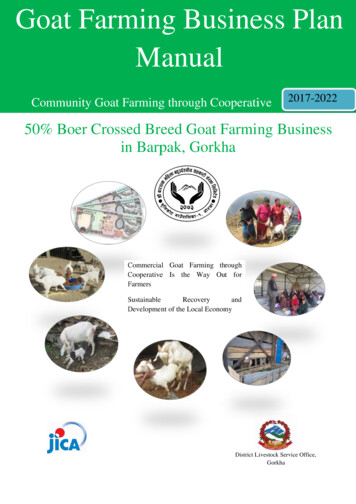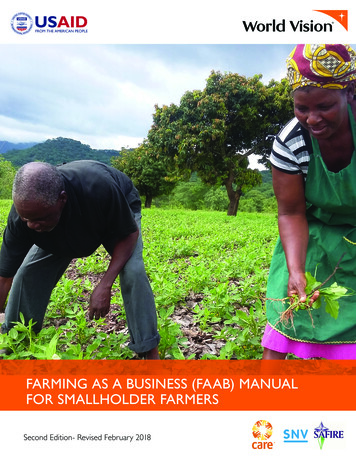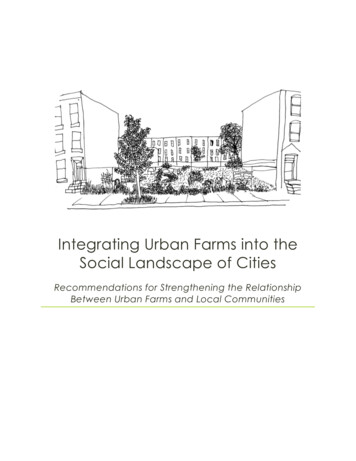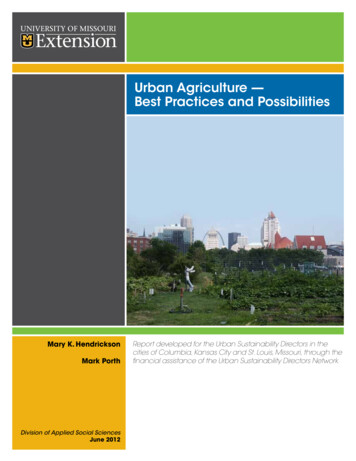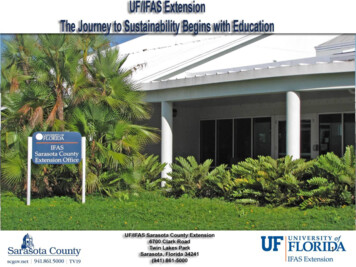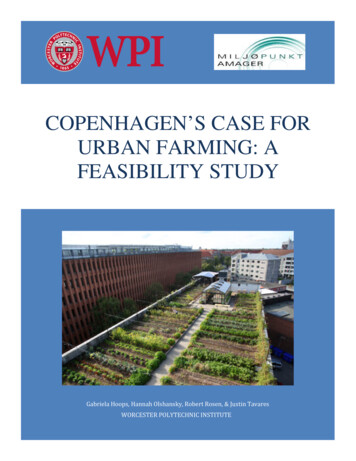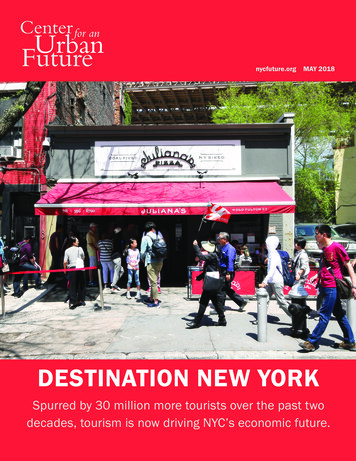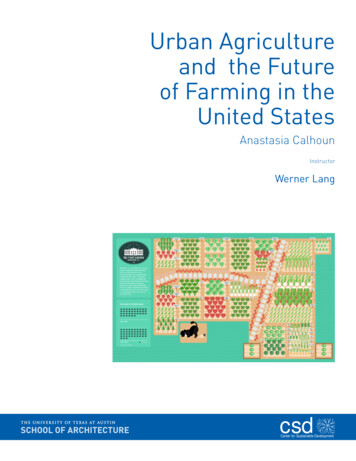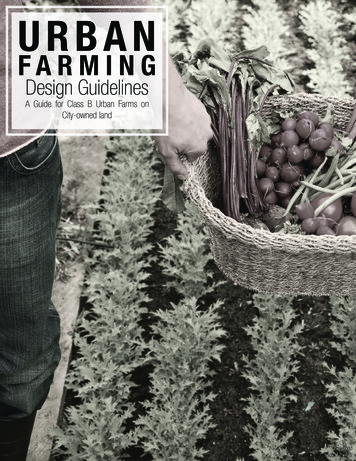
Transcription
URBANFARMINGDesign GuidelinesA Guide for Class B Urban Farms onCity-owned landSole FoodPhoto by: mommyfootprint.com/
“Cultivators of the earth are the most valuablecitizens. They are the most vigorous, the mostindependent, the most virtuous, and they aretied to their country and wedded to its libertyand interests by the most lasting bonds.” Thomas JeffersonGREENEST CITY SCHOLAR PROJECT FOR THE CITYOF VANCOUVERThe Urban Farming Design Guidelines were produced byChristopher Szymberski for the Department of Social Planning andthe City of Vancouver as an initiative of the Greenest City ScholarProgram in partnership with the University of British Columbia. It isa living document capable of being updated and edited to fit theneeds of both urban farmers and the CoV.Thank you to James O’Neill for his guidance and support on thisproject.Also a special thank you to Sarah Carten, Michelle Schouls, andTara Simmer for their valuable input, as well as, the VancouverUrban Farming Society.iiURBAN FARMING DESIGN GUIDELINES
TABLE OFCONTENTSWhat is Urban Farming?Why Urban Farming?Application & IntentRegulation & StandardsUrban Farming Design Guidelines1.0 Siting & Orientation1.1 Lot Size1.2 Siting1.3 Orientation1.4 Adjacencies2.0 Landscaping2.1 Fencing2.2 Gates2.2.1 Pedestrian Gates2.2.2 Vehicle Gates2.3 Border Plantings2.4 Drainage & Grading2.5 Soil2.6 Public Spaces & Accessibility3.0 Utilities3.1 Water Access3.1.1 Water Access and Use3.1.2 Rain-water Harvesting3.1.3 Grey-water Harvesting3.2 Electrical Access3.3 Lighting3.4 Washrooms55-6779999 - 1010101010111111111111 - 1212121212 - 131313141414URBAN FARMING DESIGN GUIDELINESiii
3.5 Metering4.0 Signage5.0 Waste Management5.1 Organics Management5.2 Recycling5.3 Garbage6.0 Structures6.1 Greenhouses6.2 Equipment Sheds6.3 Other Structures7.0 Food Processing & Storage7.1 Processing Spaces7.2 Kitchen Spaces7.3 Other Considerations7.4 Food Storage7.4.1 Dry Storage7.4.2 Refrigerated Storage7.4.3 Frozen StorageivURBAN FARMING DESIGN GUIDELINES141414151515 - 1616161617171717 - 181818181818 - 19
What is Urban Farming?It’s a growing businessUrban farming differs from other types of urban agriculture (i.e. community gardens), andis defined as the production and cultivation of fruits and vegetables for thepurpose of selling, precluding honey, eggs, and other agricultural activities at this time.These operations may be operated on a for-profit, non-profit, and/or social enterprise model.Why Urban Farming?How food connectsUrban Farming provides many benefits, such as greening the city, improving biodiversity,making use of under-utilized spaces and producing food closer to home. Since food isgrown primarily for sale, Urban Farming also enhances the local economy by creating greenjobs (including food retail, distribution and processing), building skills and shortening foodsupply chains.Urban Farming supports several goals of the Greenest City Action Plan, primarily bycreating healthy ecosystems, a lighter footprint, and a greener economy:Access to Nature: The landscapes and ecosystems of Urban Farms contribute to the City ofVancouver by increasing the number and diversity of planted spaces that other organismsdepend on for habitation; filtering both air and water; enhancing the quality of urban life;creating new and more accessible food opportunities; and, acting as places of identity andpride for residents and communities.Green Economy: Urban farming is inherently a green job, as the practices of cultivating,breeding, and propagating plants increases the biodiversity and abundance of nature in anoften grey urban world. The ability of food to connect is undeniable, and this goes for itseconomic value as well. Growing, handling, processing, storing, delivering, cooking, andserving; food is at the center of a key energetic and resource cycle that nourishes the city, itspeople, and its businesses.Lighter Footprint: The fossil fuels used to transport, cool, and store food is considerable, andis one of the largest contributors of GHG emissions – accounting for almost half of the Cityof Vancouver’s ecological footprint. By shortening the supply chain and reducing the energynecessary to import food from abroad, urban farming can supply fresher food at a lowerecological cost to the city.Local Food: Urban farming is a tangible and visible way of embedding food into theURBAN FARMING DESIGN GUIDELINES5
City of Vancouver’s urban landscape. What and how we eat serves as a reminder of ourinterconnection and dependence on the Earth’s natural systems to provide for us what notjust we need to survive, but also what we need to enjoy food of our place.Urban Farming supports several goals of the Healthy City Strategy, primarily byaddressing Feeding Ourselves Well, but also is applicable to the goals of CultivatingConnections; Active Living and Getting Outside; Lifelong Learning; and Environments toThrive In.Feeding Ourselves Well: Urban Farming can provide access to sufficient, safe and nutritiousfood. Food nourishes our bodies and our minds, and is often central to our social gatheringsand cultural traditions. Additionally, Urban framing strengthens community connections,boosts local food production, and bolsters our resilience in the face of climate change andthe disappearance of agricultural land.The Vancouver Food Strategy: The City of Vancouver has set a goal to increase cityand neighbourhood food assets by 50 per cent over the 2010 levels by the year 2020.Urban Farming supports all of the goals within this strategy:Support Food Friendly Neighbourhoods: Urban farming will be located in diverse areasthroughout the City of Vancouver, primarily in residential zones, but also in commercial andindustrial zones. Regardless of its location in the city, urban farms can act as a place ofconnection and pride in the neighbourhood.Empower Residents to Take Action: “The most effective community food systems are shapedby the people who live there” (The Vancouver Food Strategy) By having urban farms andsupporting businesses in the neighborhood, connections are made between residents andidentity of place and evolve around not just the farm as a place, but as an embodiment ofpeople and their work.Improve Access to Healthy, Affordable, and Culturally Diverse Food for all Residents: UrbanFarms act as immediate places of interface between a neighbourhood’s food system and itsresidents. Urban Farms enable the sale of produce directly from the farm to residents.Make Food a Centerpiece of a Green Economy: Food and farming, with the support of theCity of Vancouver, can offer skills-building and job opportunities in the larger green economyof the city.Advocate for a Just and Sustainable Food System: Urban Farming is a small, but important,part of a larger network of agricultural activities at the regional, provincial and national levels.Its presence and local support have radiating effects though out the larger discourse on foodsecurity and agriculture.6URBAN FARMING DESIGN GUIDELINES
Application & IntentWho this document is forWhile recognizing that there is a wide variety of farm operations, layouts, and designs,each with their own needs, the intent of this document is to outline the basic technicalrequirements for urban farms operating on City-owned land or those which may bedeveloped or constructed in the City of Vancouver in regards to the City’s Rezoning PolicyFor Sustainable Large Developments on privately owned land, which requires defined plansor studies to be conducted. Additionally, it is intended to inform and assist City of Vancouverstaff in better understanding design considerations for Class B Urban Farms, as defined bythe policy entitled Urban Farm Guidelines, passed by City Council on March 8th of 2016.Site selection, site planning, layout design, and urban farm infrastructural componentsare addressed within this document. They are intended to outline the minimum designrequirements for urban farms, as well as, provide other considerations that would furthersupport the operations of farms in the City of Vancouver.These guidelines are intended to be used by city staff in assessing urban farming proposalsto ensure that urban farms operating on city owned land meet basic design considerations.The use of the following specifications is subject to interpretation and discretion by City staff.Regulations & StandardsApprovals for Urban FarmsIn addition to these guidelines, other approvals and permits are required for the designand construction of urban farms. The Food Policy Group in the Social Policy Department,must approve all urban farm plans, and should be consulted in the earliest planning phase.They will be responsible for evaluating urban farm applications against the technical designguidelines which follow in this document. They will assist in interpreting the guidelines foreach situation. Additionally, the Facilities Planning Department will need to review all builtstructures and infrastructural components to ensure that a suitable level of quality anddurability in achieved.If the urban farm is sited on either City of Vancouver-owned or private land, Development,Building and other Permits may be required. For detailed information concerning thesepermits and other relevant codes and requirements, contact the City of VancouverDevelopment Permit Group of the Planning Department or the Permits and LicensesDepartment.URBAN FARMING DESIGN GUIDELINES7
Urban Farming Design Guidelines:The following document outlines the technical design guidelines for Class B Farms operatingon City-owned land. The guidelines contained in this document outline the minimumrequired components for urban farms, while also putting forth other additional and ancillarycomponents for consideration. As such, the focus of this document is on the productivespaces of urban farms, which are those used for the cultivation of market fruits andvegetables and are not directly open or accessible to the public. Where the public doeshave open access, guidelines are given. (The farm may choose to have or host social andpublic spaces, beyond the productive operations of the farm, for gatherings or educational/therapeutic activities)Each farm will have a unique context and set of needs; including:- Anticipated longevity of the farm’s lease or use of the land;- Operational intentions, whether as a full productive farm, or having educational ortherapeutic components;- Type of crops;- Organizational structure;- Production model;- What financial models the farm may be using or financial resources that it has access to;- What neighborhood or area of the city that the farm is located;- Environmental context (tall buildings, presence of pavement, proximity to roads or publicproperty etc.)Design Guidelines for Urban Farming1.0 Siting & OrientationThe siting and orientation of a farm is crucial. Because agricultural crops require a minimumof eight to ten hours of sunlight a day to flourish, it is important to situate farms in places thatwill provide adequate sun exposure. However, due to the nature of the urban environment,this may not always be possible.Other important aspects in siting an urban farm are its proximity to other food assets andhow it is situated in the community in relation to the larger landscape and functioning of thecommunity. Urban farms have the potential to be a symbol of pride for a neighborhood, andcan, therefore, bring people together, as well as, provide aesthetic and ecological benefits tothe area.1.1 Lot Size(a) The size of the site for Class B, whether in a single parcel or as multiple parcels operatedjointly, may not exceed 7000 m2, unless relaxed by the Director of Planning;1.2 Siting(a) Urban Farms shall be located to maximize sunlight access; with full southern exposure;(b) It is recommended that spaces, which are accessible to the public, act as transitionspaces between the public realm and the productive space(s) of the urban farm;8URBAN FARMING DESIGN GUIDELINES
(c) It is recommended that communal or educational spaces be sited adjacent to publiclyaccessible spaces, such as streets, paths, plazas, etc when possible.1.3 Orientation(a) It is strongly suggested that a minimum of 8 hours of full sunlight shine on the site duringthe Spring/Fall equinox.(b) Urban farms, their planting layout and structures, should be oriented toward the south sothat beds and rows of annual plants, herbaceous perennials, and edible shrubs and trees donot shade out each other unnecessarily, with taller plantings on the northern end of the site.1.4 Adjacencies(a) It is recommended that urban farms be located in a place that provides easy access to aroad or lane for the delivery and pick-up needs of the farm; garbage and recycling pick-up;etc.(b) Consider locating urban farms near other community food assets, such as: communityfood markets, community kitchens, community gardens etc.2.0 LandscapingLandscaping is defined as the aesthetic appearance of the urban farm, but also includesthe infrastructural components of the farm that define its boundaries, paths, planting beds,and the grades of its grounds. Unlike other agricultural operations in rural areas, urban farmsoperate in very different environments that require them to conform to the aesthetics of theurban environment.2.1 Fencing and BoundariesAs many farms will be operating outside of the public realm, it is important that theirboundaries are clear, and that, where needed or desired, fencing prevents access. Fences,which are linear structures that enclose an area, are usually constructed from secured postswith boards, chain link, or other material spanned between. As such, Fencing can be costlyto install and maintain.The adjacencies of the farm; its location in the city; the local demographics; zoning context;and operational intentions of the farm; etc. will determine whether there is a need or adesire to fence the perimeter of the farm. Additionally, the context of the urban farm will alsodetermine the specifics of the fence’s design (i.e. material, height, openness, etc.)(a) The entire perimeter of an urban farm shall be enclosed or demarcated, providing visualboundaries, as well as, physical boundaries where needed or desired;(b) Fences should be provided of sufficient height per security requirements and operatorspreference;(c) Fences should be constructed with sufficient material strength to prevent access oftrespassers;(d) Fencing material should prevent the access of animals (i.e. dogs, skunks, raccoons, etc),URBAN FARMING DESIGN GUIDELINES9
(e) Fences should be visibly porous;2.2 Gates2.2.1 Pedestrian Gates(a) Urban farms should have two pedestrian gates which provides access to fenced areas;(b) Pedestrian gates should be no less than 1m (3’4”) wide, to provide easy access of wheelbarrows and wheel chairs;(c) It is recommended that gates be self-closing with latching and locking mechanisms.2.2.2 Vehicle Gates(a) Urban farms should have a minimum of one vehicle gate, dedicated to the loading andunloading of materials;(b) The vehicle gate should be a minimum of 3.5m (11’6”) wide, and lockable;(c) It is recommended that the gate be a rolling gate with a wheel, which slides along thelength of the fence, providing an efficient use of space.2.3 Border PlantingsBorder plantings are the public ‘face’ of the farm, presenting the aesthetic quality of the farmto the surrounding area. As such, it is important that the farm take care in designing andplanting this edge as a show of good will and as a positive addition to the public sphere.(a) Plantings outside of the fenced urban farm, in the public sphere, should use edibleperennial and herbaceous annual plants that produce edible fruits, nuts, vegetables, flowers,etc.(b) Border plantings should be designed in such a way to be enable easy maintenance.(c) It is suggested that border plantings use permacultural planting principles;2.4 Drainage & Grading(a) Drainage of surface water should be directed away from buildings, gates, entrances, andfrom going across sidewalks or onto neighboring properties;(b) Ponding or pooling should be avoided.2.5 SoilSoil is the “Skin of the Earth”. It is a mixture of minerals, organic matter, gases, liquids, andcountless organisms that together support life on Earth. It is the medium in which plantsgrow, and its health and quality is essential for the successful cultivation of agriculturalcrops. The soils found in an urban environment are often disturbed, having been previouslyexcavated, compacted, or polluted. Due to these conditions, sites for urban farming shouldensure that they have appropriate soil on site, or import it from reputable sources if needed.(a) It is recommended that existing on-site soils be tested for toxins (heavy metals, salinityand hydrocarbons) prior to being used in urban farming operatoins;10URBAN FARMING DESIGN GUIDELINES
(b) Imported soil should be clean and produced with organic standards, and it isrecommended that imported soil be obtained from local sources;(c) If raised planting beds are used, it is recommended that soil depth be a minimum of450mm (18”);(d) Toxic materials, such as pressure treated wood, should not be used where they will comeinto contact with soils that are growing food.2.6 Public Spaces & AccessibilityPublic space, as an extension of an urban farm, is separate from the productive operationsof the farm, and offers unique opportunities for both the community and the farm. Theiroverlap can be a space for activities, classes, and social gatherings, and other hosted events.It is a place for the community to meet. It is a place where farm and community interact andexchange, amidst the daily operations of the farm’s productive space.It is the social focal point of the farm. As such, the space allows for a group of people towork on tables and benches; to share knowledge and skills; to host dinners and events; etc.It may also be connected to buildings or other spaces where the farm has an office, kitchen,or market.(a) It is suggested that urban farms have or host a public space as an extension of the farm’soperational space and activities;(b) The social or public spaces of urban farms should be inviting and provide easy anddirect access from the public sphere, particularly for older adults, people with disabilities, andyoung children;(c) Selection of ground surface materials should result in easy access for older adults andpeople with disabilities.(d) The spacing of paths and path width; placement of planters; and seating and handrailsshould further encourage easy wheelchair and pedestrian access;(e) An outdoor work bench or table, for the potting of plants and other general farm orgardening activities and chores, should be provided with a height of at least 865 mm (34”)high.(f) A covered space, from the rain and sun, should be provided;(g) Consider providing planting spaces for the public to use and plant as their own.3.0 UtilitiesAccess to water is essential for the operation of farms. Other utilities, such as electricityand sewer, also serve the operations of farms and allow farms to function more smoothly,efficiently.URBAN FARMING DESIGN GUIDELINES11
3.1 WaterWater is an essential resource for farming. Its wise use and conservation is important. Whileurban farms should have direct access to municipal water, it is important that other sourcesof water are also incorporated into a larger water resource plan. When possible, rainwaterand greywater systems should be integrated into the water resource plan and be used forthe watering need of a farm first, before relying on municipal sources.3.1.1 Rainwater HarvestingRainwater harvesting provides an urban farm with an independent water supply. It is animportant source, especially during regional water restrictions and during droughts. Rainwateris collected from roofs and stored in large tanks for later use. This provides a water supplythat reduces the dependency on municipal water. Additionally, it prevents stormwater fromentering the municipal sewer system and eventually entering and polluting freshwater bodies.(a) It is recommended that rain water be harvested off of sheds, greenhouses, and otherstructures for storage and use in the productive space of the farm;(b) When applying rain water to agricultural crops, urban farms should use drip irrigation oranother method of application that prevents rain water from contacting the edible parts of theplants3.1.2 Greywater Re-useGreywater is recycled water from on-site sources, typically as municipal water which hasbeen used in processing activities. Once used, the water is no longer potable, but it can stillbe used for the needs of the cultivated plants on the farm. Used water’s redirection into astorage tank, instead of into the sewer system, preserves it for use later and reduces thedemand on city sewer infrastructure.(a) It is recommended that greywater (water that may be used on-site for washing andprocessing produce), be collected for storage and application onto the growing beds of theurban farm;(b) When applying greywater to agricultural crops, urban farms should use drip irrigation oranother method of application that prevents greywater from falling onto the edible parts ofthe plants3.1.3 Water storageA cistern is a large storage tank for holding water; potable municipal water, rain water, orgreywater. Cisterns can be purchased or constructed. Water coming from roofs may becontaminated with pollutants such as dust, metals, dirt and debris, etc. Additionally, greywatermay have dirt and debris which could clog irrigation lines. As such, it is important thatcisterns are equipped with input and outtake filters, and that they are inspected and cleanedregularly(a) Storage of rainwater should be held in a container constructed of a material safe forcontact with potable water.(b) Water storage tanks should be equipped with a screened vent, ensuring that the interiorof the tank is not under pressure, facing downward to keep airborne contaminants out of the12URBAN FARMING DESIGN GUIDELINES
water supply;(c) Water storage tanks should be equipped with an access hatch, which allows forinspection, maintenance, and cleaning;(d) To reduce the possibility of sediment intake, the point of withdrawal from the cisternshould be at least 10–15 centimeters from the bottom of the tank;(e) A It is recommended that the water storage tank be equipped with a pre-filter, to reducethe buildup of sediment and debris;3.1.4 Municipal WaterMunicipal water is clean and potable. It is important that a farm have access to municipalwater, to ensure that its water needs are met.(a) Potable water should be available on the site of the urban farm year round;(b) Hose bibs should be installed at a minimum of 7.62m (25’0”) apart;(c) Hose bibs should be frost-free with a vacuum breaker for year round water access;(d) It is suggested that drip irrigation and an irrigation controller, which controls timing,duration and zone-specific watering, be installed, as their combination provides an efficientmeans of applying water to cultivated plants;(e) If on city-owned land, a ddc, direct digital control system, should be installed to monitorwater usage3.2 Electrical Access(a) Weather-proof outlets are to be provided at all structures;(b) It is suggested that additional weather-proof outlets be provided in other strategiclocations on the farm site.3.3 Lighting(a) Motion sensor flood lights should be installed at all structures;(b) All light fixtures should be high efficiency LED, and use fixtures that prevent unnecessarylight-pollution;3.4 Washrooms(a) It is recommended that access to a washroom be considered when examining potentiallocations for an urban farm;(b) In some cases it may be necessary that a washroom be provided.3.5 Metering(a) It is suggested that all urban farms have dedicated electrical and water metering and/orsubmetering to track the usage of utilities throughout the seasons;URBAN FARMING DESIGN GUIDELINES13
4.0 SignageThe sign of a farm identifies it to the public and provides needed information in case thefarm or farm manager should need to be contacted. Signs can also be used for a farm toalso state what kind of operation they run; what they grow; etc.4.1 Signage(a) All urban farms should post at least one identification sign stating the name of the urbanfarm, contact information, with the option of further info about the farm and its operations atthe primary entrance to the farm;(b) The identification sign must comply with City of Vancouver Sign By-Law;(c) It is suggested that multilingual signs be used;(d) Consider interpretive signs that identify plants and their uses in public areas.5.0 Waste ManagementUrban farms produce green organic waste during daily and seasonal activities. Thesematerial cycles are an important aspect of any farm. It is strongly recommended that greenorganic wastes and other material cycles be managed in a way that endeavor to close theloop of materials and resources as much as possible, whether on the farm itself or as part ofthe larger cycles and processes within the city.5.1 Organics ManagementIt is important and necessary for urban farms to have a plan for the organic refuse that theiroperation will invariably produce. Organic compost is beneficial for urban farms in manyways, including as a soil conditioner, a fertilizer, addition of vital humus or humic acids,etc. By composting on site, urban farms close the nutrient cycle and can retain valuableresources.(a) It is recommended that an on-site organics composting system, one of sufficient size tomatch the needs of the urban farm, be constructed and utilized on site;(b) It is suggested that the urban farms utilize aerated bin composting, an affordable andefficient method of producing compost in a timely manner, that uses an air pump andperforated pipes to oxygenate compost piles (other approved methods of composting areacceptable);(c) It is recommended that easy access to power and water be provided;(d) It is recommended that the location of the composting system and space for the storageof finished compost be covered from the elements, with proper ventilation;(e) The organics storage and processing structures shall be constructed in such a way thatprevents rodents;14URBAN FARMING DESIGN GUIDELINES
(f) It is recommended that the location of the organics system and space for the storage offinished compost be placed on a relatively flat surface, and may require a concrete pad tofacilitate easy removal of finished compost and the cleaning of the space;(g) The organics system shall not be located near a storm drain;(h) Any effluvium discharge, which may be produced as a result of the composting process,shall comply with Sewer and Watercourse By-law to prevent the contamination of naturalwater systems;(i) Effluvium discharge from the composting process shall not drain towards garden beds.(j) If on-site organics management is not possible, the design of the urban farm must enableeasy curbside pick-up of organic material with an appropriately sized bin for temporarystorage.5.2 Recycling(a) It is recommended that an on-site area for recycling be provided which canaccommodate the needs of the urban farm;(b) It is suggested that additional storage space be provided to temporarily store materialsor resources that can be reused in different capacities by the urban farm or be incorporatedinto the CoV building material salvage plan.5.3 Garbage.(a) It is recommended that an on-site area for solid waste disposal, which is not capable ofbeing composted, recycled or otherwise disposed of, be provided which can accommodatethe needs of the urban farm, and allows for storage of such materials for a minimum of 14days.6.0 Greenhouses & ShedsStructures for storage, working, and growing give a farm necessary functional space that canbe versatile and multi purpose. Covered spaces also provide a surface from which rain watercan be collected.6.1 GreenhousesGreen houses are very most valuable and functional structures for farms. They are essentialspaces which are used to start seeds and grow cool loving plants in the winter; growcontainer plants for the fields in the spring; fully cultivate heat loving crops through thesummer and fall; and back again into the winter for seed starting, potted plant storage, andwinter crops. (A greenhouse larger than 10m² requires a building permit and must conformwith Vancouver Building By-law.)(a) It is recommended that an urban farm have a minimum of one green house;(b) Greenhouses should be capable of being securely locked to protect against potentialvandalism or pest and wildlife access;URBAN FARMING DESIGN GUIDELINES15
(c) The greenhouse should be constructed of material that can withstand warm and wetenvironments for prolonged periods of time without rotting or becoming structurally unsound;(d) It is recommended that polycarbonate sheets be used for the glazing of greenhouses,which is economical, lightweight, diffuses lights, and shatter proof,(e) It is recommended that the greenhouse be capable of being opened in multiple locationsto allow cross ventilation, or be outfitted with a ventilation fan.6.2 Equipment ShedsEquipment sheds are indispensable structures for storing the necessary equipment ofrunning a farm such as: rototillers, mowers, and wheelbarrows; as well as more simple toolssuch as: hoes, shovels, rakes, etc. (A storage shed larger than 10m² requires a buildingpermit and must conform with Vancouver Building By-law.)(a) Urban farms should have a minimum of one storage shed for tools and equipment;(b) Sheds should provide protection from the elements;(c) It is recommended that shed have a large entrance that enables easier movement oflarger equipment (mower, rototiller, etc) in and out;(d) Sheds should be securely lockable to protect against potential vandalism or pest andwildlife access;(e) Sheds should be equipped with a hose bib and electricity;(f) It is sug
Urban farming differs from other types of urban agriculture (i.e. community gardens), and is defined as the production and cultivation of fruits and vegetables for the purpose of selling , precluding hon
